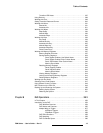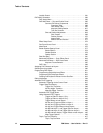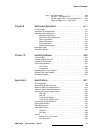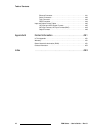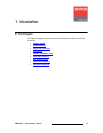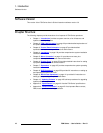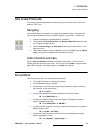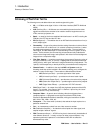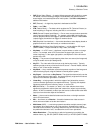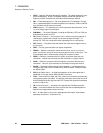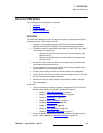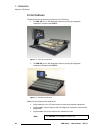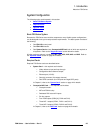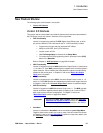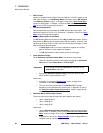
FSN Series • User’s Guide • Rev 01 21
NK==fåíêçÇìÅíáçå
Glossary of Switcher Terms
• DVE (Digital Video Effects) — A special effects generator with the ability to create
PIP effects, reduce and enlarge images, create borders and shadows around
those images, and create keyframes for motion paths. See PIP and Keyframe for
additional information.
• EXT (External) — A digital key input that is dedicated to the DSK.
• Fader — see T-Bar.
• FTB (Fade to Black) — The button which enables the TD (Technical Director) to
fade everything on Program, including the DSK, to or from black.
• GPIO (General Purpose Input/Output) — One or more communications ports that
control input and output "triggering." For example, with a GPI (input) trigger, an
external peripheral device can trigger a specified switcher function. With a GPO
(output) trigger, the switcher can trigger an external device.
• GUI (Graphical User Interface) — A term that describes a status display based on
graphics and icons, rather than strictly on numbers and letters.
• HD-SDI (High Definition Serial Digital Interface) — a high definition SDI signal
(SMPTE 292M). Example formats are 720p, 1080i, and 1080p.
• Keyframe — In a PIP “move,” a keyframe is a point where an action or change
occurs. For example, when a PIP moves from the upper right corner to full
screen, keyframe 1 is the upper right position, and keyframe 2 is the full screen
position of the PIP.
• Keying — The process of superimposing video from one source (the foreground)
on top of another source (the background).
• Key Fill — The video which fills the hole cut by the keying circuitry. Typically,
switchers provide a variety of choices for the fill source — internal mattes, external
video, or "self" fill are several examples.
• Key Mask — A key modification system that protects a portion of the foreground
video from being keyed, using the switcher’s internal pattern system.
• Key Signal — also known as Key Source. The signal that electronically cuts the
hole in the background video signal. Key signals typically originate from external
inputs such as character generators or cameras.
• Linear Key — a keying mode in which the edges of anti-aliased key sources
(such as character generators) are reproduced clearly. Typically, two separate
signals are required from a linear key source: a cut and a fill.
• M/E (Mix/Effects) — The section (or "bank") of a video switcher where video
signals are processed to select inputs and create mixes, wipes, keys and other
effects. An M/E is essentially a video layer that can be combined with other M/Es
(layers) to form the entire output of the switcher.
• Menu — A term used to describe buttons and functions on the high-resolution
color LCD touch screen.
• Mix — also known as a Dissolve. A transition between two video sources in
which one source fades out as the other fades in.
• Multiviewer (MVR) — a monitoring system that enables multiple sources (input
and outputs) to be displayed on one or two monitors, eliminating the need for
individual source monitors. By utilizing different arrays of PIPs, users can select
the preferred multiviewer “look,” and streamline control room operations.
• Native Resolution — The resolution to which all processing is set within the
switcher frame, e.g., SD-SDI (SMPTE 259M, Level C) or HD-SDI (SMPTE 292M).



